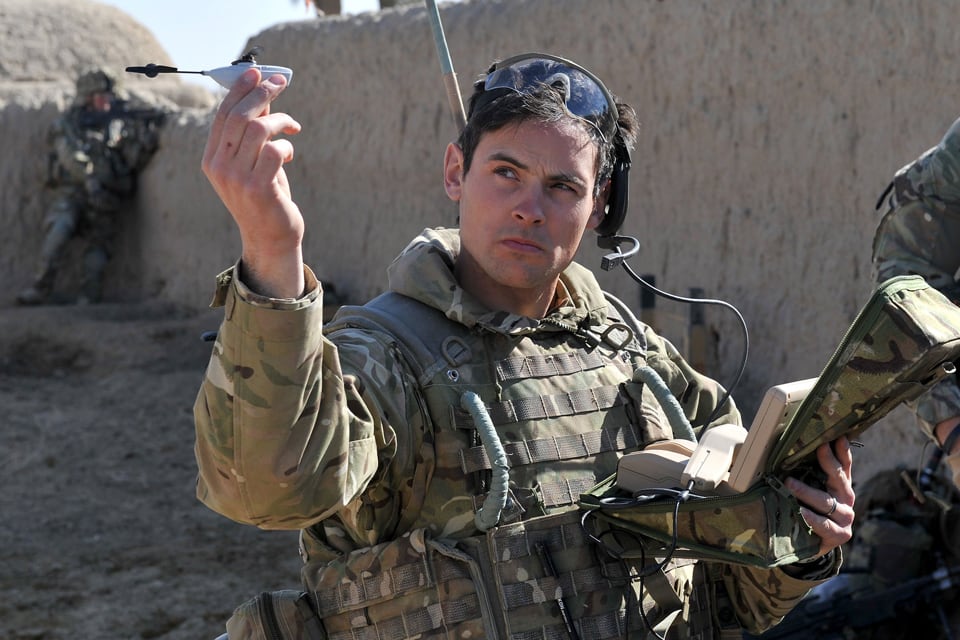The Army is moving forward with a plan to put has taken a key step towards handing pocket-sized drones in the hands of to its dismounted soldiers by 2018. squads, with plans for broad distribution through a funded program in 2018 and limited fielding before that.
The service on On March 1 the Army requested information papers from industry on what technology might be available for what it’s calling Soldier Borne Sensors . The Maneuver Center of Excellence at Fort Benning, Georgia, has a preliminary set of requirements and plans to go back-and-forth with industry on what already exists or could become quickly available.
. The Maneuver Center of Excellence at Fort Benning, Georgia, has a preliminary set of requirements and plans to go back-and-forth with industry on what already exists or could become quickly available.
"We’ve had numerous studies as well as experimentation within our battle labs. We continue to see that soldiers are kind of lacking at the squad level for relevant information that’s immediately around them," said Phil Cheatum, deputy branch chief of electronics and special developments at MCoE, said Tuesday.
But he also added: "We don't know what we don't know about what's out there right now."
Unmanned aerial systems such as Drones like the Gray Eagle and Shadow, which are part of native to larger units, have improved situational awareness capability for the Army. But a squad trying to clear a city block or go over a hill can remain blind to more detailed and rapidly changing threats. A quickly-deployable SBS would give allow squads real-time ability to inspect its most intimate threats.
The technology and concept are not new. British and Norwegian forces have been using PD-100 Black Hornet drones since about 2012, and the British have heavily leaned on them in Afghanistan. Last spring, the Army tested them along with a number of other gadgets at Maneuver Battle Lab Army Expeditionary Warrior Experiments at Fort Benning. U.S. special operations forces have deployed with them.

Sergeant Scott Weaver, of The Queens Royal Lancers launches a Black Hornet, Nano UAV from a compound in Afghanistan during Operation QALB. Op QALB is a joint ISAF and ANSF operation, its aim is find enemy caches and disturb Insurgent supply chains.
Photo Credit: Sgt Rupert Frere/RLC
Cheatum said the Army hopes to learn lessons from those early adopters to find the best capabilities and seek a more affordable solution better priced for a much larger more vast distribution population.
"The only problem we'd have with a capability like that [is] the Black Hornet is individually handmade," Cheatum said. "When you're talking about individually handmade, you're talking about an expensive piece of equipment."
Lt. Col. Timothy Fuller, product manager for soldier maneuver sensors at MCoE, said the there will be an industry day on April 12, the first of many over the next couple of years.
At AEWE last year, soldiers said the Black Hornet would have been invaluable during past deployments.
"I was in Basra [Iraq]. There's a lot of roads that you don't really know where they go," Staff Sgt. Andrew Smith told Army Times a year ago. "In Afghanistan, I can't tell you the number of times you just want to know what's on the other side of a hill."
Requirements for SBS — informed by experimentation efforts like AEWE — remain preliminary and fluid at this point; the Army isn’t publicizing detailed specifics. But Cheatum laid out some basics:
• Max weight of 150 grams: The device should weigh less than a third of a pound and ideally fit into a cargo pocket to avoid adding any additional burden to soldiers already loaded down with gear.
• Deployable within 60 seconds: Soldiers should be able to get it in the air quickly.
• A 15-minute flight time: The Army needs the SBS to stay in the air long enough to capture relevant information and, ideally, return to its operator.
• Capable camera: Cheatum said it should be able to detect a human-sized object within 50 to 75 feet with "90 percent probability." The camera will provide soldiers a real-time feed.
• Wind tolerance of 10 to 15 knots: While such a small UAS likely won’t fly in rough conditionsa hurricane, Cheatum said the SBS should be able to operate in light winds.
• Range of 500 to 1,200 meters: With line of sight, the drone should be operable from a reasonable distance, with the ability to bring it home after gathering the intel.
The Black Hornet weighs just over half an ounce (18 grams) and, including the controller, the system weighs just under three pounds (1.3 kg) total, according to maker Prox Dynamics. It can fly for about 25 minutes at a speeds of up to 11 miles per hour and has a line-of-sight range of 1600 meters. Cameras can be aimed and send a live feed to the controller while also able to take still more detailed still shots.
According to the British Ministry of Defence, a 2013 Black Hornet contract for 160 units cost £20 million (roughly $30 million, or about $190,000 per PD-100).
a 2013 Black Hornet contract for 160 units cost £20 million (roughly $30 million, or about $190,000 per PD-100). (KJ NOTE: If you check the math, keep in mind exchange rates shift over time...used a rough estimate of early 2013 exchange rates and rounded).
(KJ NOTE: If you check the math, keep in mind exchange rates shift over time...used a rough estimate of early 2013 exchange rates and rounded).
Kyle Jahner covers soldier uniforms and equipment, Medical Command and Recruiting Command along with investigations and other breaking news for Army Times. He can be reached at kjahner@armytimes.com.




